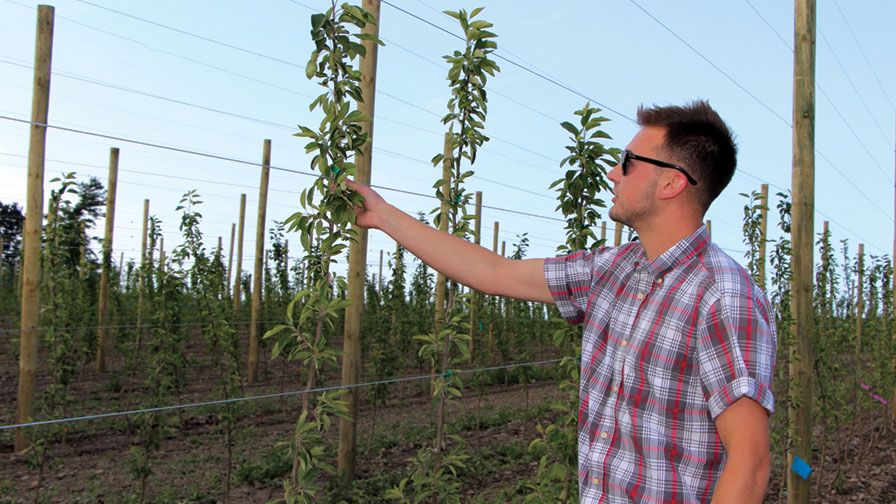Young Grower’s Apple Training Shows Innovation and Investment

“Get the limbs in place as soon as possible,” Jimmy Zingler says of his 2-D hybrid training system. (Photo: Christina Herrick)
Jimmy Zingler looks over a young planting of ‘Aztec Fuji’ and says “We’ve put a lot of investment into this.”
Zingler is a young grower who operates Zingler Farms, a 700-acre farm in Kendall, NY, along with his father, Mike.
Mike Zingler is a first-generation progressive farmer and Jimmy is following in his footsteps. Jimmy Zingler, 25 years old, is among a wave of young growers coming back to — or sometimes never leaving — their orchards. He’s been working on the farm full-time for the last six seasons.
The Zinglers have been rapidly renovating their 350 acres of apples, planting ‘SweeTango,’ ‘Kiku,’ ‘Koru,’ and ‘Smitten.’ Jimmy says they’re looking to add ‘Sweet Cheeks’ in the near future.
But following his first visit to orchards in Washington, Zingler says his reaction was “We have to quickly up our game.”
So, Zingler came up with an idea to grow a hybrid 2-D vertical, formal system to increase light interception into their canopies, which would then boost yields and, especially, fruit quality. “This system is somewhat of a hybrid as we’ve left a bottom wire absent so that people can pass through our rows perpendicularly and not be fenced in,” he says.
A Modern Growing System
The Zinglers have planted an 11-by-3-foot 2-D formal system with 1,320 trees per acre for the last three seasons. For the next planting in 2018 they will significantly increase tree density by narrowing tree and row spacing but plan to continue to use a formal training system for all forthcoming plantings. The focus, he says, is to train limbs on both sides of the central leader down to each of the seven wires. The first wire is placed 4 feet off the ground, with wires then every 18 inches up to 13 feet high.
“It creates systematic rules for the tree,” he says.
The system is a very narrow canopy, with goals of four to six apples per 1.5 foot limb trained to wire and about 1-2 apples per short lateral shoot, or dard, coming off of the central leader. The Zinglers also use hedging and say this intense focus on training will help boost yields and quality as well as make their orchards “robot ready.” Zingler is also experimenting with another shorter hybrid system that only has three wires, with the bottom wire starting 4.5 feet from the ground, as well as several pedestrian systems.
Don’t Overlook the Details
Ideally, a limb that is 3-to-4 inches above the wire is taped down to the wire, Zingler says. Apogee (Valent BioSciences) is applied to specific areas of the tree where allotted space has been filled.
“Get the limbs in place as soon as possible,” he says.
He’ll score as well as notch branches and the central leader where there is blind wood, and is looking at the use of Promalin (Valent BioSciences) to promote branching in these areas.
The Zinglers also hand blossom thin and chemically thin blossoms off young trees to maximize growth, although Zingler acknowledges chemical thinning cannot be as precisely managed.
Bud thinning also helps keep the fruit count down per limb.
“You have to make time to get through these blocks,” he says of the care he and the orchard workers take to train limbs to the wires of their system. “You can’t miss opportunities.”
Advice for Fellow Young Growers
The experience of visiting the largest apple-producing state was invaluable, says Jimmy Zingler, a young grower from Kendall, NY. Zingler has visited Washington three times; twice with the International Fruit Tree Association and once with a group of New York young growers in 2016.
Zingler says traveling is something he hopes all growers — whether embarking on their fruit-growing careers or seasoned veterans — see as an important component of modern apple growing.
Whether it’s across the street or across the country, “Get off of your own farm and see what others are doing,” he says. “You can go to 100 farms and every one of them is doing something different.”










